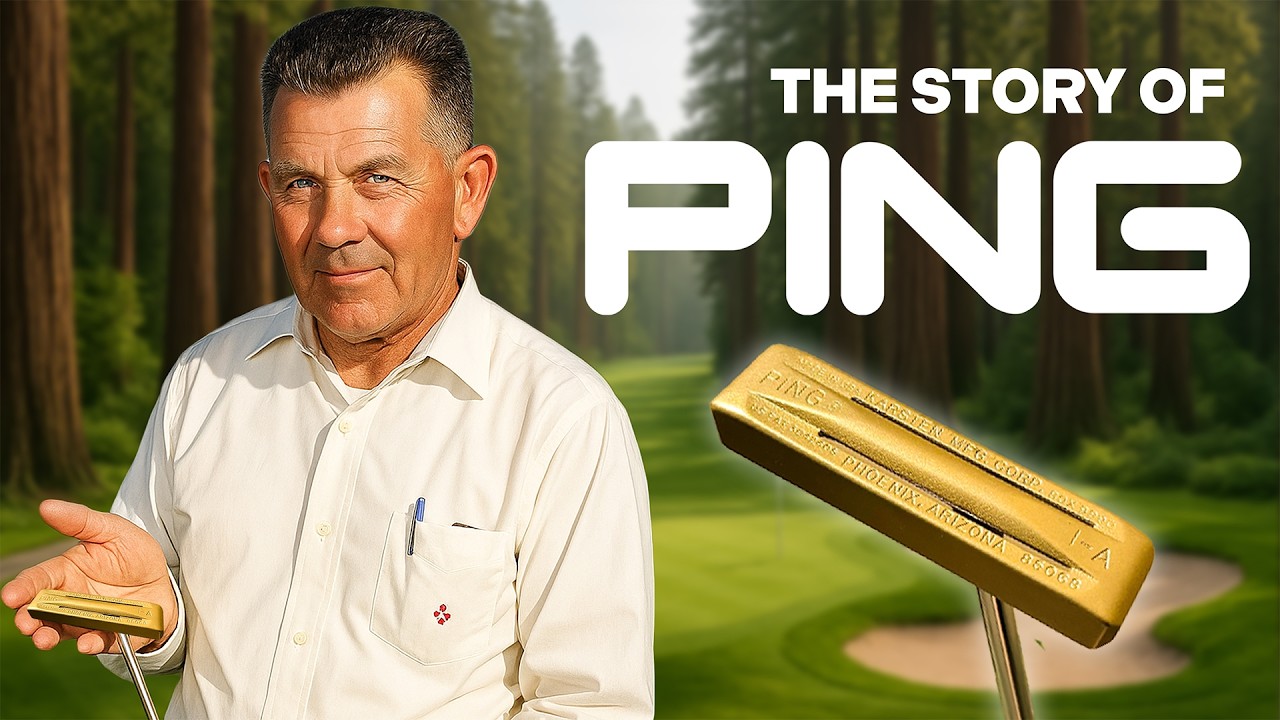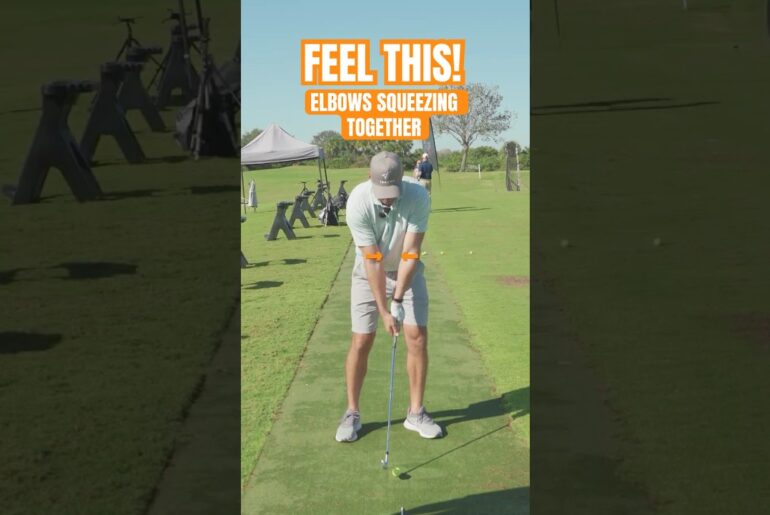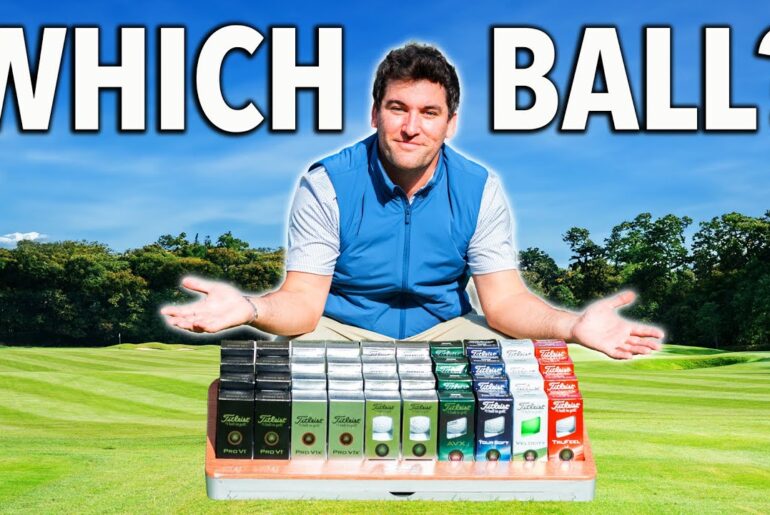In 2025, PING is a household name in the sport of golf.. but it didn’t start that way. Our video today tells the story of the company’s humble beginnings in a Silicon Valley garage and how it grew to become one of the giants of the golf world.
Huge thanks to PING for opening its doors and giving us access to this amazing story.
Follow us!
Instagram: https://www.instagram.com/randomgolfclub/
TikTok: https://www.tiktok.com/@randomgolfclubofficial
What if I told you that one of the leading club manufacturers in history started 65 years ago in a Silicon Valley garage? It’s a story of humble beginnings, scientific breakthroughs, and a putter with a different sound. I thought there must be a way to make a putter that’s easier to play with and one that’s more forgiving when you mishit it. And so I build up a putter with weight on the toe and heel. And then I met a pro that says, “You know, you putt awful good.” And I says, “Well, you should have seen me before I made my putter.” In 1913, just 2 years old, Karsten Soulheim arrived in America. The son of a Norwegian shoe maker, he grew up in Seattle, learned the family trade, became an engineer, and later helped design G’s first portable television. Karsten was a scientist, a problem solver, and in 1959, in a small garage in Redwood City, California, he started building golf clubs. More than half the PGA Tour uses some of the 75 models of the Ping putter. And in the past four years, more than 50% of PGA tournaments have been won with a Ping. I think the gentleman is a genius. Yeah, I think that he has a degree in mechanical engineering. And when he came out with those ping putters, he became a genius. Karsten’s son, John A. Soulheim, told me that if I wanted to understand ping, I needed to see where it all began. [Music] How often do you get back up to Redwood City? Not very often. So, you’re the youngest or I’m the youngest by six years. You know, the youngest you can get away with a lot, right? Uh, well, let’s put it this way. My mother told me that if I had been the first, I still would have been the last. [Music] On the corner here. Yep. That’s it. My dad built that rock wall. Oh, really? Still standing, huh? Still standing. Before Silicon Valley, this was a leafy suburb of a quiet town. Allan, John’s older brother, meets us at the house, and the woman who lives here greets us like old friends returning home. All right, we’re going to walk inside this historic house in the world of golf. The house that Ping built here. We have a a surprise here that’s been mailed in advance. This. Do you remember this? Sure do. They recognize the putter right away. Of course they do. They built it right here in this house. It doesn’t have 1A on the bottom. So, this is a very early putter. So, this is 59 or 60. Yeah. It’s the same grip. The same grip. I mean, the grip is in perfect condition. Yeah. You look at the work that was done on this, the way you ground the top and bottom, the toe. It’s square. The thing is they’re perfect. It’s like done done on a mill. Okay. But it wasn’t. It was done by hand. That’s how good my dad was. He just had this like passion and drive to solve problems, work hard. This is John K. Solheim, CEO of Ping, and you guessed it, Karsten’s grandson. I was this assistant. I think I was like 16 or something like that, and he was probably close to 80, and just wore me out. Just go, go, go. So every once in a while we’d sneak away and take a nap, but outside of that, like he was going up and downstairs all day long, just always on the move. I learned from him like to be successful, you got to be like busy getting things done, and you can’t just sit back and let it happen. Karsten didn’t just reimagine the golf club. He reimagined the process, design, research, building, and testing. A legacy strong enough that it would carry him all the way to the World Golf Hall of Fame. the only engineer ever to get there. I asked John what it was like working alongside his father back when all of this was just an idea. My dad would generally watch the late news. I’d had done my homework and went to bed and I’d hear a wrap on the window that there’s windows between my room and the garage and it was time to go to work. So I got got up and helped my dad. I started getting paid then. It was quite a deal that he he made. It was more of a business lesson because I got $2.50 for every putter that I built. And this meant from rough head, totally grinding it, shafting it, gripping it, and uh shipping it. It’s strange to think that right here, golf would change forever. My dad would take uh butcher paper, put it on the ground, and then he had the trainer putter, which had weights that you could move either to the toe and heel or to the middle so that you could see what was happening. He put a wire going to the back and basically it would show what was happening at impact and that would be drawn on the butcher paper. Yeah. There’d be a little zig in there, you know, because on some level engineering it’s it’s I’m beginning to understand it. It it seems like part of the problem is understanding what’s happening. Yeah. Measuring reality. Yeah. Karsten didn’t just test his ideas, he lived them. The first woods as far as in designing the for the airflow, he knew that a golf ball got up to 100 miles an hour. So, he had had me drive the car at exactly 100 miles an hour early in the morning when it was calm. You know how kids uh when they put their hand out the window and it goes up and down? He would do that with the wood, changing it into different shapes. How many kids get to go 100 miles an hour with their father in the car? He was the head engineer on the fireball jet. It was the first jet for landing on an aircraft carrier. One of his comments was that when it would take off on a the aircraft carrier, it would be very stable, but when it came in to land, the wings would be rocking back and forth. Very dangerous. And that was because the fuel was in the wings. And that’s probably where he realized that it makes a difference with heel and toe waiting, right? Was it clear to anybody? Because perimeter waiting, look, can we just say perimeter waiting might be the most significant impact that Carson and your family has had on golf. Is that is that probably accurate? Yeah, that’s I mean there’s many that made the biggest change. It’s the most copied. Yeah. Right. It’s it’s and it’s now in every golf club, right? The waiting as as a cuz cuz prior to that, no one was thinking about that at all. First of all, did people think you guys were crazy? Number one, and number two, who internally knew that this was the way of the future? When when did you realize, “Aha, this is a light bulb moment. This is going to change everything.” Well, my dad knew it right away, you know, and just took forever to convince other people. Back then, Ping wasn’t a household name. It was a handshake. It was a hope. It was a garage dream to make golf more enjoyable. I was working at Palo Alto Municipal Golf Course and Pat Mahoney was my boss and my father would come and pick me up when I got off and he had practiced putting and Pat Mahoney said, “You really puted good.” He told him before he made this putter, he did not putt good. He said he made this putter with heel and toe waiting and it takes more inertia to to twist. And Pat said, “I’d like to sell a putter like that.” Karsten said that he would do that. And Pat said, “You’d sell a million of them.” Like, boy, I think it was within 24 hours that um we had that prototype made. So Pat was the first paying customer. Yes, definitely. This is a photo taken right here and and John took it with his box camera. Yeah, with a box camera sitting on a fence that was over here. We’re looking at our largest shipment ever. It was sold to a company. They wanted a 100 putters and so we built the 100 putters for them and that was our biggest shipment ever. Yeah. That’s Karsten Louise. Yeah. I don’t know if you know the story on why he grew the goatee. No. Tell me. Even Karsten’s signature goatee had an engineer’s logic behind it. A jeep accident in India left him with stitches in his chin. Too tender to shave. He let the beard grow in and a trademark was born. But that’s where Karsten had a cut. Yeah. On his chin. Yep. And that’s why he grew the goatee to hide the scar. The goatee started up at the top and then as it healed it it went down. Now my mother said he liked the goatee because of the fact the steartus would come up and do that to him. One of the pieces of iconic of who he was was sort of solving a problem. Uhhuh. Oh yeah. Yeah, that’s right. Back in Phoenix, John sits at his desk with a familiar object, something that would become just as iconic. We always kept a piece of clay. Uh my dad did, and I still have clay at my desk, and I sat down and made the little man. Now, my dad was about to leave on a three-month worldwide trip, and he saw the man and said, “I want to see him when I get back.” When he got back, my brother Allan had built a 3 foot one out in front of our building. And uh, you know, Mr. Ping became the Ping Man. At the time, did anyone have any idea what was about to happen? I mean, as far as we never thought it would grow like it did, and we were probably getting 100 putters a week out of the garage, you know, and now we’re on like 50 acres. So, yeah. And a,000 employees. Yeah. You know, it’s just it’s unreal. That’s right. More than 1,000 loyal team members. Each member of the team carries on with Karsten’s desire to help golfers play their best through innovative and quality products. My dad always wanted to improve. Wherever he was, he wanted to get better, and that’s what we’ve taken on. That’s fascinating. Should we roll a few putts in here? Just to be clear, we are reenacting perhaps the first putt ever with a ping putter. Okay. Right. I mean, this is mere feet from where it was ever. Like, Carsten spent days and days making this putter as a frustrated golfer and brilliant engineer. Came upstairs one night before dinner and made the first putt. Yep. Is this true? Very true. Here you go. Let’s They were We’re going to reenact it right here. This is This is so cool. And it was be He didn’t even realize that the putter would make a noise until he hit it. And it only made the noise when you hit it in the center. If you hit it off center, it it wouldn’t uh wouldn’t ping. So, immediate feedback. Immediate feedback. So, this is so cool. And he makes it. Wow. That is so cool. And it sounds beautiful. Uhhuh. May I try? Sure. You’re a good putter. Beautiful. I missed to the right, too. Do you want to do another one? Yeah. No hesitation. That’s how you know you really have the golf bug. There we go. There it is. Yep. Soulheim brothers have got it. The first putter we made, when we hit a ball, it said Ping. So what other name could I give it? So Ping it is. It was the Ping 1A that named the company, but it was the answer that proved Karsten wasn’t just on to something. He was changing everything. Well, the 73-year-old genius who opened his ultramodern plant in Phoenix in 1967 makes 2300 putters a day. Hey, Carsten had been working on a new putter for a while. He came and told Louise, my grandma, that he had, you know, a new putter. He’s like, “I need a name for it.” Everybody’s using Palmer’s putter. He said, “I got to find an answer to it.” And I said, “Well, call it the answer.” He said, “That’s no kind of a name for a putter.” And I said, “Well, you said you wanted the needed to get the answer to Palmer’s putter.” And uh so there’s your answer. He said, “It’s too long a word. won’t fit on the space I’ve got. I said, “Leave the W out. That’s a big wide letter and it doesn’t make any difference in the way you pronounce it. A N S E R.” And he liked that. He liked that. So that’s how the answer came about. And I’m glad I stuck to it. Success with the answer wasn’t Karsten’s first breakthrough. Before golf, he was chasing better signals. He did the cabinet for General Electric’s first portable television. Along with that, the rabbit ears antenna. It was the first rabbit ears that you could mount to the back of the set and be able to tune it in. My dad didn’t get anything for it, but after they sold the first million, he got a goldplated set of rabbit ears antennas. And after the second million, he got another set. I think that’s what gave him the idea, the gold putters. Kind of a special place. My dad wanted something to give to the golf pros, thanking them for winning with his putter. This is the results of that. There’s over 3,000 putters in here. This is Ping’s putter vault. Every professional victory is enshrined in gold. It’s a memory bank for every putt that ever mattered. And watching John A handle these putters feels like flipping through family photos. So, what are those, John A? They’re uh Tiger Woods US amateur wins. There’s not a lot of rooms in golf that have this much history compressed into this little amount of space. You know, that’s for sure. Crazy putter is one of my designs and it’s one of the there’s a lot of crazies in here. It actually took 51 prototypes to do that. John shows me a putter he personally designed. It’s hard not to think of that garage back in Redwood City. Standing here, you realize golf isn’t really even about clubs. It’s about people. It’s about stories and it’s about obsessions. Getting fit here feels a bit like getting your oil changed by a Formula 1 pit crew. And you ever wonder who first believed clubs should fit the player, not the other way around? It was Carsten. And it started with the color code system. Simple dots of color that made custom fitting possible for everyone. I’m going to take a measurement. Going to do a height to wrist floor. Get you in the color code cuz that’s where we start. That’s what that’s what Ping’s known for is our color code system, right? So, we’re going to start there. This is James Lee, a master fitter at Ping. And what I want you to do is just relax the arms and look straight ahead. So, 36 and A2. Why this is important is I have short arms. You could have short arms, you could have long arms. What should it be? There is no wrong or right with arm length. God’s creation. And you say you’re a six point something with that swing. You should be lower than that with that swing. James, let’s do it, dude. We have our blueprint S. Okay. And we have our i530. What’s this one? This is more of a This blueprint also a different color code. Oh, okay. Cuz I didn’t know what color code you were going to be. So, I brought all of them with me so I can do the adjustability on that. Dude, this is like a I feel like we’re in a dentist office outside, you know? This is great. Open wide. There we go. I I’m kind of really excited to look at like not so much what I can do for the iron, but what the iron can do for me. And that’s what it’s about. Yeah. Right. It’s about me fitting to you, not you fitting to the clubs. Exactly. I’m so excited. I’m so excited. Right. So, you’re going to see that difference at a dress. Yeah. There’s your straight shot. Wow. That is absolutely works as advertised. That was a twoft draw. That’s why color code is important. That is insane, dude. They sound good, too. They’re They’re clicky but soft. Yes. There we go. We’ve got the irons dialed in. Now it’s time to test Ping’s newest driver. This is the new 440 LST. I mean, you do, again, you do your normal swing. Don’t try to manipulate anything cuz I can make some changes on there if I need to. The head looks It’s a little smaller. It is. It’s a little bit smaller, right? Well, you guys got some like robotic That’s our automatic picker. Oh, man. So, we’re going to try a tensei tense. Oh, Eric, that’s so good. That was nice. That was a long ball. That was a real long ball. 285 325. Oh, so good. Eric, we’re going to stop on that one. Okay, we’re done. Yeah, it’s pretty good. We’re dialed into the tensei. Tensei sensei. Yeah. All right. We have two options here. This is the fourwood, but I can go standard three-wood length, which is 43, or I can go 42 and a half and go to a fivewood length. Oh, I like the fivewood length with the four-wood head. Okay. We’re going to change that direction. You can change the line angle here by three degrees. That’s insane. There we go. That tempo was so much better, Eric. That was nice. There we go. Great ball, Eric. Yeah, it felt good. Great ball. There we go. Getting Fit by James is more than custom. It’s personal. It’s easy to forget how special that experience is until you feel every shot start to make sense. Now, it’s time for the final piece, the one Ping built its name on. All right, putter fitting. It’s time. It’s time. This is a big day. The first putter I ever had was the Ping Answer. And so I’ve gone through probably 50 putters since then. So it’s cool to be back here and learn all about Ping putters. This is our putting table. Five pieces of black granite put together. It’s 70 tons, 45 ft 10 in long, 6 1/2 ft wide. It is leveled to within 1/ 1,000th of an inch. So it’s about as flat of a surface as you’ll find anywhere. And that just helps us make sure that whatever we observe is, you know, attributed to the putter and not any outside influences. When we look at this here, you know, we like to see these eyes either fall over that ball or in a perfect world, right on the hoszle, right where they’re at there. Oh, okay. This is important because if these eyes start to move too far inside or outside that line, it is going to start to change your perception of where the hole actually is. So, we started with an answer. We call that an H neck. You’ll hear it called a plumber’s neck. That provides a very kind of neutral middle ground to start with. Okay. So, not necessarily a bad option for you, but we might look at something that perhaps has a little more a little more towy. Correct. Oh, that’s heavy. You like that? Yeah, I like it. Okay. How does that Huzzle just look to you at the address position? Looks okay. Yeah. Okay. It actually feels like Yeah, feels nice. Okay. You know, when we change a club to feel softer or firmer, what we’re actually changing is the impact and the sound of the putter. So when we mill into a putter face, we start to remove the surface area that makes contact with the ball and that kind of brings out some of the high pitch frequencies. Oh, interesting. And when we have a smooth face and have more of that surface area making contact, we introduce those high pitch frequencies back. And it is either the absence or presence of those frequencies that your brain is going to pick up on and tell you that’s hard or that’s soft. Interesting. We’ve done some really cool testing in here where we’ve kind of made putters like one putter that would feel very very soft and one that feels very firm. made them look identical and put these ear muffs on people so they can’t hear the sound and you ask them to tell you which putter is soft and which putter is firm and without that context of sound you’re not able to do it. Whoa. What were some of the biggest challenges that Ping faced sort of in the beginnings of essentially disrupting uh the golf industry? My understanding the biggest challenges were like being ruled non-conforming uh by the ruling bodies. So, we had a a bent shaft innovation where right below the grip there was a bend uh in the shaft that all our irons had. So, basically made all our irons non-conforming. And then after that uh we had the groove issue where our grooves were conforming, but then they changed the rules. They kind of put our grooves outside of conforming and everybody else stayed conforming. In 1984, when the rules allowed square U-shaped grooves and irons, Karsten began manufacturing his Pingai 2 sets of clubs, which quickly grabbed about a one-third share of the new club market, more than double their nearest competitor. Then, in 1987, the US Golf Association made the 30° tangent rule, which would ban Pingi 2 clubs from all 13 USGA sanctioned events starting this January. The USGAA uses a 30° tangent from Karsten’s rounded groove edge. Whereas Karsten contends the distance between the walls of the groove should measure the width. The USGA measurement makes Ping eye grooves wider. Therefore, the grooves are too close together according to the rules. The groove issue took so much out of my dad. You know, it just his mind was preoccupied with it. And it took about 3 years out of his real engineering type of mind. It it was kind of sad. Innovation doesn’t always make friends, especially when it challenges the rules. If Carsten hadn’t gotten into golf, yeah, perhaps there would have been another invention. Definitely. He was trying to improve upon everything. What drives a person like that? What What is that? He wants to do it better, you know? And I mean he’d improve a sand wedge and we’d have few thousand heads there of the old one and no he wanted to get the the new one in in production and ship that to the people because he wanted them to have the new the new one and would scrap the the old throw them away. He’d throw them away. Yeah. They would be remelted back down. Yeah. So really a desire to to deliver satisfaction, not to sell a product. Yeah. And I I would say John and John K. Soulheim, John’s son, um are the same way, wanting the very best and finetuning until they get the best. Some memories live in photo albums, others in a few faded pencil lines on a wall. What are these like too? See, I don’t think I don’t know if that was ours or yours. Oh, we we had a water scale here and we had a pulley up here. Uh, and we hung the putters here and we would stamp the weight on some of them of what a lot of the putters back then. So, you’ll see some numbers stamped in the bottom of those putters that you have. Okay? And that was the weight of the putter. Yeah. So, okay. But it’s not in ounces. It’s not in that, but it’s it’s a displacement scale. So, in other words, a tank of water with a rod going down into it. Oh my. I never even Greg. So, where did Greg go? It was only a little bit of weight difference between the the We never painted that for that reason. Yeah. It’s original. We found history in the garage. Old stories, the start of it all. But to see what Ping has become, you have to follow that legacy out from the garage and onto the factory floor. All right, so we’re getting the clubs made. Part of a much bigger puzzle here. Ping golf clubs don’t sit on the shelf. Every club is built to order. It all starts with the head, grouped by color code. Each one ready to become something unique. The head and shaft come together with glue baked in a custom oven. At Ping, even the bond has to be specially engineered. Each iron is calibrated by hand, and each loft and lie is made personal. Then the shafts are trimmed to length. The process is measured and precise. It’s like watching a group of artisans at work, not merely an assembly line. Grips are added, a tow weight, and the perimeter waiting is fine-tuned. I suddenly remember these are my clubs and it’s finally time to use them. Over the last couple of hours, these clubs, these clubs, oh my god, and these clubs have all just been made. What does it mean to you that Ping remains a family-owned business in a world dominated by large corporations? It gives us full control. So all the shareholders are family members and I just know from you know friends that run other business and stuff you get private equity involved or go public or whatever you’ve got all these shareholders to answer to and it just sounds like a real pain. I see the reasons to do that to bring in funds and help grow your business, but golf’s a pretty mature business. So it’s not like we need to make this huge investment somewhere that we can’t afford ourselves. And I like having full control and not having to listen to private equity guys that might not even play golf or understand the business and the history that we have. I definitely like love being outside when the weather’s nice and just enjoying like the golf course. I think that’s the beauty of it is yeah, you’re playing a sport, but like it’s just beautiful around you and just enjoying and even when the weather’s bad, it’s kind of like you know what, let’s uh suffer through it together and you know, have a good time. I’ve heard so many people with the like, you know, where you don’t hit it good on the face, but the ball still goes good and they’re like, “Thank you, Carson.” So, to me, I still have that when I like kind of get away with a bad shot. I’m like, I say, “Thank you, Carson.” And it makes me think of him and you know how he was just trying to make the game more enjoyable. I’ve always loved Desert Golf and today is all the more special because of my playing partners. I’m joining John Kay and his son Sutherland, a junior at the University of St. Andrews. He can practically see the old course from his dorm room window. Golf runs deep in the Soulheim family tree. In many ways, it’s the thread stitching generations together. Playing alongside a father and a son, it feels like someone else is here, too, completing our fourball. With every drive that lands on grass and every putt that falls, I can’t help but think, “Thank you, Karsten.” Golf is a strange game. It can be lonely if you choose to allow it, but it can also connect you to a place and to a time. Every swing carries a bit of history with it, and every club carries its mark of the maker. And yes, maybe Ping started with a better putter, but it became a brand focused on curiosity. The game changes, equipment evolves, but truly great ideas always start at home. Ping story isn’t finished. The best ones never are. [Music]








31 Comments
Will you play the Ping Irons? I would love to know how they work for you.
All I know about Ping is the family has a REALLY nice log cabin outside of Flagstaff. That place is huge.
Of course, it had nothing to do with "excellent" marketing too, right…?
Best product placement and advertisement I've seen yet! Impressive. Hats off.
Speaking as the youngest of 5 by 7 years, I can attest to the built-in advantage’s of being “the last.” 😎
Great video!
I guess he made it through the R&A 'obstacle course' –that designed to thwart anything you present to it for approval!
I work at a big box store that sell golf clubs, and I inherited a club set from a PGA grounds keeper (20+ years). I never knew PING was American made for their top level clubs. Nice to know, and a selling factor to promote sales of their clubs.
This gave me so much joy to watch. Thank you Erik and Ping
Awesome video and story. Loved my Ping irons but they're gone on now to a younger golfer. Best company ever to deal with, had a bent shaft or something one time, sent it in, they repaired and returned NO ChARGE! Who does that?? PING!!!
My family owns a public 18 hole facility in Northeast Ohio. We are approaching our 65th season of golf and our 43rd year being contracted with PING as our ONLY retailer in our Pro Shop. My aunt (director of golf) will never forget Karsten himself walking into our shop in the early 80s to meet our head professional to talk about the specifics of a potential contract. We are still here to this day and our relationship with PING is now over 40+ years.
What a lovely video, ping has been in my golf bag for 40 years, eye, all the way up to G440….and its unlikely there is a better putter ever invented than the Anser
I love my ping 1-a and my Anser so much. I wish they would bring them back, but I know magnesium bronze isn't used as much anymore so I doubt they'll bring it back
I own a Ping Anser from 1968. It was my Fathers. Best putter I've ever used and that sound it makes does something to my soul.
Thank you! That was a great documentary. My first club set was Ping Eye2 over 35 years ago. I still have them.
That was a great video. Beautifully narrated and telling a fantastic story of golf and family.
Love my pings! Been playing the same set for 20+ years now
Watching this truly made me proud to be a lifelong ping user.
Thank you, Karsten!
Thanks for this amazing story, your research was exceptional, especially visiting Karsten's house in Redwood City where it all began. I've been using Ping clubs on and off for over 40 years (more on than off) but in 2024 I went back to Ping irons after an amazing fitting at my club and the i530 irons are just fantastic.
Great video–well done!
Dude, what an amazing story. Thank you for putting it together.
Erik, this doc was a masterpiece.
So so interesting, I now want to buy something Ping haha
Wish he spent more time in and with the factory workers
Wow, I’m really glad I watched this.
A big thank you to Karsten and all of the Solheim Ping team. My name is Rick and back in 1997 I moved to Tempe to go to Arizona State. Prior to 1987 I was an accomplished golfer. I played to a 2 handicap…in October 1987 I wrecked on a motorcycle and was paralyzed from the chest down. I still love the game and wanted to play from my wheelchair but getting a golf club to be flat enough on the loft and lie was a real big challenge (from my garage that had one hammer and one screw driver)
Sit down in a chair with your golf club and see how the toe is almost 2 inches off the surface… when hitting … the heal would dig into the turf almost making it impossible to play….and get the ball airborne.
1997 I wrote Ping a letter asking if they could help me.
Not only did they say yes… they built me a set of clubs with a bag. The tv news channels did a whole bunch of stories on my new clubs, how the Ping build team got all crazy creative…making clubs for playing golf from a wheelchair.
I went to the ASU Karsten golf course (driving range) across the street from campus and hit golf balls for the tv people…It was awesome! I felt like a celebrity.
I still have the clubs and the bag.
Today, May 2025, I live on a golf course in Mesa Arizona. I can’t thank you guys enough… all that help, support and creativity allowed me to continue my love and joy for the game of golf..🏌️♂️⛳️🙏😀
Fairways and Greens…Rick
I don't play golf but I watched to the end.
Truly the best 30 minutes I've spent on YoutTube in a very long time. Thanks for telling us the great story of PING.
What a superb story, and beautifully told. Thank you!
The only downside is I think I need to go buy some ping irons now 🤣
Hands down this is the best YouTube mini documentary I’ve ever seen. EAL you absolutely killed it!
Ping easily has the best customer service I have ever experienced. Our family only plays Ping and they take great care of us
"the best ones never are" awesome stuff